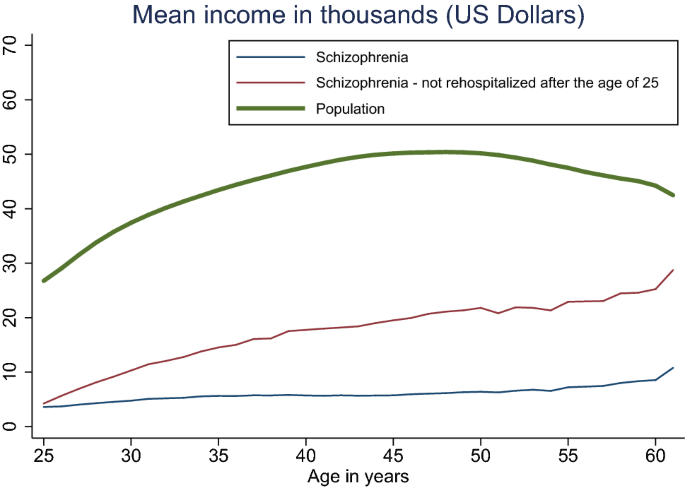schizophrenia life expectancy australia
Research shows poor heart health is to blame for a 25 year-life expectancy gap between those with schizophrenia and the general population. The age adjusted Death Rate is 010 per 100000 of population ranks Australia 46 in the world.
Correlation Between Life Satisfaction And Mental Illness
People with schizophrenia are 2 to 3 times more likely to die early than the general population 3.

. Excess mortality from physical. Cigarette smoking lack of exercise poor diet and frequently doctors dont check for issues like diabetes and heart disease etc as quickly as they should in people who have schizophrenia. Which means people diagnosed with schizophrenia.
Schizophrenia can subtract an average of 145 years from a persons life expectancy. We review the reasons for this and what can be done to mitigate it. Schizophrenia is frequently associated with significant distress and impairment in personal family social educational occupational and other important areas of life.
Physician Info About Efficacy And Safety When Starting A Treatment. In Australia up to 70 per cent of people who have a first episode of psychosis will have another episode within two years. With schizophrenia my thoughts can be like pieces of a mismatched jigsaw puzzle Joshua Gliddon.
Review other causes of death by clicking the links below or choose the full health profile. The decline in life expectancy among people with severe mental health conditions ranges from. Those patients dying of natural causes die of the same diseases as in the general population.
Most studies of schizophrenia show a life expectancy reduction of 1020 years. The life expectancy of patients with schizophrenia is reduced by between 15 and 25 years. Studies show that schizophrenia may reduce life expectancy by an average of 145 years.
According to the latest WHO data published in 2018 Schizophrenia Deaths in Australia reached 49 or 004 of total deaths. More worryingly the life expectancy of Australians diagnosed with schizophrenia is reduced by 32 years. Wiki Australia ranks dead last 192 compared to other countries in the measurement of the effect of the overall disease burden DALY for schizophrenia.
This is often due to physical illnesses such as cardiovascular metabolic. Corresponding numbers for schizophrenic women was 163 years for bipolar men 136 years and for bipolar women 121 years. People with schizophrenia tend to live between 14 and 20 years less than the general community.
Life expectancy The overall weighted life expectancy for people with schizophrenia was 647. Life-expectancy was 187 years shorter for schizophrenic men compared to men in the general population. It was developed by the World Health Organization in the 1990s as a way of comparing the overall health and life expectancy of different countries.
This is true - for a number of reasons. A 2017 systematic review and meta-analysis found that. Subscribe for FREE to the HealthTimes magazine.
In 2009 the World Health Organization WHO identified underlying global risk factors for mortality in the general population. The average lifespan of a schizophrenic is shorted up to 10 to 25 years. Research studies over the past few decades suggest that life expectancy can be reduced by as much as 15 years on average in people diagnosed with.
Ad Learn More About How To Support Patients with Schizophrenia On Their Treatment Journey. One reason is that people. Although there was some variation between samples we estimate that people with schizophrenia lose 1315 years of potential life and that life expectancy is about 60 years for men and 68 years for women.
We quantified years of potential life lost to schizophrenia and life expectancy in people with schizophrenia. Life-expectancy was much shorter in persons with schizophrenia or bipolar disorder. Australians with schizophrenia die 25 years earlier than the general population according to a new study.
The life expectancy of patients with schizophrenia is reduced by between 15 and 25 years.

Management Of Schizophrenia And Common Comorbidities By Prof Baune

The Association Between Early Onset Schizophrenia With Employment Income Education And Cohabitation Status Nationwide Study With 35 Years Of Follow Up Springerlink

Mifwa On Twitter Did You Know That The Average Life Expectancy Of Someone With Schizophrenia In Australia Is 54 We Need To Close The Gap And Improve The Physical Health Of People

The Gap In Life Expectancy From Preventable Physical Illness In Psychiatric Patients In Western Australia Retrospective Analysis Of Population Based Registers Abstract Europe Pmc

The Gap In Life Expectancy From Preventable Physical Illness In Psychiatric Patients In Western Australia Retrospective Analysis Of Population Based Registers The Bmj

What Is The Life Expectancy For People With Schizophrenia

Years Of Potential Life Lost And Life Expectancy In Schizophrenia A Systematic Review And Meta Analysis The Lancet Psychiatry

Many People Mental Health Coalition Of South Australia Facebook

The Association Between Early Onset Schizophrenia With Employment Income Education And Cohabitation Status Nationwide Study With 35 Years Of Follow Up Springerlink

Difference In Life Expectancy Among 145 799 Men With Recent Onset Download Scientific Diagram

Prevalence Of Schizophrenia In North America Europe Australia And Download Scientific Diagram

Smoking And Mental Illness Results From Population Surveys In Australia And The United States Springerlink

On Average People With Schizophrenia Die Earlier Than The General Download Scientific Diagram

Ranzcp Guidelines On Schizophrenia A Synopsis By Prof David Castle

Difference In Life Expectancy Among 124 971 Women With Recent Onset Download Scientific Diagram

Active Five Year Prevalence Of Mental Disorders In People Aged 15 And Download Scientific Diagram

Global Regional And National Burden Of 12 Mental Disorders In 204 Countries And Territories 1990 2019 A Systematic Analysis For The Global Burden Of Disease Study 2019 The Lancet Psychiatry

Years Of Potential Life Lost And Life Expectancy In Schizophrenia A Systematic Review And Meta Analysis The Lancet Psychiatry
